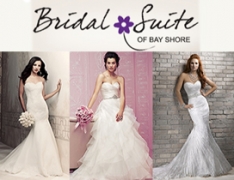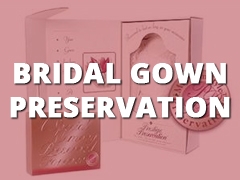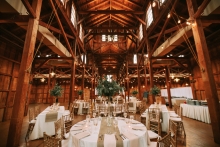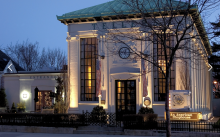 Marriage is a lifelong commitment and it all begins with a promise literally set in stone. Engagement rings, as we know and define them today (a diamond set atop a precious metal) is said to have been inspired and popularized by Archduke Maximillian who presented on to Mary of Burgundy around 1477. Before this, these tokens of betrothal were simply, simple metal bands. Gold and Silver bands were customarily worn by the wealthy, and iron by "commoners".
Marriage is a lifelong commitment and it all begins with a promise literally set in stone. Engagement rings, as we know and define them today (a diamond set atop a precious metal) is said to have been inspired and popularized by Archduke Maximillian who presented on to Mary of Burgundy around 1477. Before this, these tokens of betrothal were simply, simple metal bands. Gold and Silver bands were customarily worn by the wealthy, and iron by "commoners".
Engagement rings today are typically worn by the woman as a symbol that she "is spoken for" or "taken" and soon to be wed. And, in North America, Ireland and the United Kingdom, these rings usually feature an exquisite and beautiful diamond or gemstone. However, in some cultures matching engagement rings are worn by both parties, (men and women), and double as wedding rings.
Although customs vary across the globe, North American, Irish and English tradition call for wearing one's engagement ring on the left hand ring finger (the one closest to one's heart, it is said). Also, while in days gone by it was customary for the man to pick out the ring and the woman to accept it as a symbol of her agreement to future marriage, times have changed. Many (if not most) couples today embark on coupledom starting with choosing the engagement ring (and their wedding rings) together. Some couples even go as far as offering each other promise rings, or pre-engagement rings symbolizing their love and their intent to get engaged and eventually married.
After marriage, the engagement ring may be replaced by the wedding band or both can be worn together. In fact, some brides choose to have their engagement ring and their band fit neatly into each other or simply soldered together.
Keep in mind that modern modality mandates that the man spend at least two month's salary on his precious princess and the precious gemstone he presents her with.
Ready, Set, Propose:Before picking out a gorgeous gem to grace the hand of the one you love, couples should first consider selecting a setting for it to comfortable and elegantly sit in. And, the selections are as vast and unique as the couples themselves. From traditional and classic...modern to eclectic that options are endless and there's something to suit every taste and every personality. Here are just a few.
Solitaire:Simply sensational. This classic creation is designed to show off your gorgeous gemstone. And while simple it is elegant and chic and one of the most popular designs for high quality gems. Simply put solitaire means "one"...one diamond (or gemstone) perfectly perched on a clean, sleek band with no other accents or side stones to distract from the spectacular sparkler. This is the ring for the consummate romantic as the meaning behind it remains quite profound. The single gemstone symbolizes the union between the two of you. It represents the single and powerful love that you both will share for the rest of your lives.
When it comes to the carats of a diamond, or the size of a diamond, the larger is it, the more rare the stone. In general, diamonds found in nature are usually smaller in size. That means, the larger the stone the more rare and valuable it is. Diamonds are measured in carat weight in a 100-point scale. Therefore, a 50 point diamond is the same as a ½ carat diamond. Diamonds are usually desired larger in size to more easily show the cut, color, and clarity of the stone. The cut of the stone, though, can make the diamond appear smaller or larger than others of the same weight.
Pave:This unique and interesting design is comprised of an array of smaller gems, typically diamonds, set closely together. The stones are separated and held in place by tiny bead of the setting metal. The result: An intricate design that resembles a continuous surface of diamonds or other gems.
Tension Setting:This modern masterpiece is a sleek finger ring whose main feature is that the stone is held in place by pressure rather than by prongs, a bezel or some other mounting. The metal setting is literally spring-loaded placing pressure on the bauble with tiny etching/grooves added to the metal creating a shelf for the gemstone's edges to rest....making it look like the bauble seem like it's suspended in air.
Three-pronged Setting:Many modern day three prong setting also feature a triad of gems mounted together. And, frequently a larger, more impressive look is achieved by placing three smaller diamonds or stones together. This setting is designed to allow more light to pass through for greater light and more intense color, brilliance and fire. Prong setting tend to be the most popular holding the diamond or gem in place as if it were hanging, and allowing for that extra sparkle and glow.
Other types of settings include bezel, channel, flush, cluster and invisible.
Diamonds are a girl's best friend: While other gems and baubles are gaining in popularity, when it comes to engagement rings it seems like diamonds are still a gal's BF.
Diamonds are valued according to four characteristics: Carat, Cut, Color, and Clarity. The combination of each of these 4 C's helps determine the stone's worth. So, when selecting your stone, it best to find the right balance of the four essential elements.
Carat:Refers to the mass of a diamond. Larger diamonds tend to be more valuable. Why, well, besides it's rarity, larger stones show off color, cut, and brilliance to their greatest capacity. Diamonds are measured on a 100-point scale, with a .50 carat diamond being equal to a 50 point diamond or 1/2 carat gemstone. Keep in mind however, that while size is important there are other key factors that contribute to the desirability and value of the stone including color, clarity and cut. Furthermore, some cuts can make the stone seem larger or smaller than it really is.
Cut:A properly and well cut stone dazzles with color, light, and luster....and it is the only characteristic affected by the human handling. A correctly cut diamond allows light to refract through it in such a way as to give it that extra luminescence and WOW factor. Improperly or poorly cut gems include those that are cut too deep or to shallow preventing some of the light from passing through the stone and therefore compromising it's brilliance. Needless to say, the better the cut, the more expensive the stone.
Color:Color is graded using a letter scale ranging from D to Z, with stones receiving a D to F being those that are totally colorless and transparent and also the most coveted and valuable. Gems that receive lower letter grades frequented have yellow or brown hues to them, making them less desirable and less "precious". Colorless stones are considered ideal because they reflect light more sharply and allow for an amazing rainbow spectrum of color. To the contrary, stones that receive grades in the Z+ category are considered "Fancy" color diamonds.
Clarity:A stone's purity increases it's worth...generally because the more pure a stone, the more brilliant and dazzling it will be. Contrary to popular belief that some diamonds are "perfect", most all diamonds have some type of inclusion or identifying characteristics. Many of these characteristics or inclusion are only apparent under 10x magnification making them virtually invisible to the naked eye and therefore have little effect on the gem's appearance.
Diamonds are placed in groups according to how much they are included. Flawless stones are at the top of the clarity grading scale and are the most rare and most valuable. Stones with limited inclusion are graded VVS 1 or VVS 2, and those with visible inclusions are graded on a scale from I1 to I13. The amount of inclusions as well as the size and color of these inclusion also impacts a diamond's value and desirability.
Shaping Your Future: Your future began to take shape the moment the two of you met and now you both have the chance to shape your future starting with picking the shape of your engagement ring.
Cushion Cut Diamond: The cushion cut is a classic and romantic cut that just recently regained its popularity. This diamond is an antique cut that's a cross between the Old Mine Cut ( a deep cut with large facets intrinsic to the late 19th and early 20th centuries) and a modern oval cut. It is often also known as the pillow-cut or candlelight diamond ( a term given to cuts designed before electric lights referring to the stone's brilliance and equating it with the luminance of a candle.
The cushion cut is a classic and romantic cut that just recently regained its popularity. This diamond is an antique cut that's a cross between the Old Mine Cut ( a deep cut with large facets intrinsic to the late 19th and early 20th centuries) and a modern oval cut. It is often also known as the pillow-cut or candlelight diamond ( a term given to cuts designed before electric lights referring to the stone's brilliance and equating it with the luminance of a candle.
Oval Cut Diamond: This nouveau chic design was first introduced in the 1960s and is known for its elliptical shape that make it look larger than a round stone of equal carat weight.
This nouveau chic design was first introduced in the 1960s and is known for its elliptical shape that make it look larger than a round stone of equal carat weight.
Round Stone Diamond: This cut is known for being the most brilliant...after all it was designed by a brilliant mathematician. Marcel Tolkowsky in 1919 determined based on his calculations that this shape stone offered the most luster and shine.
This cut is known for being the most brilliant...after all it was designed by a brilliant mathematician. Marcel Tolkowsky in 1919 determined based on his calculations that this shape stone offered the most luster and shine.
Emerald Cut Diamond: No, the gem isn't an emerald nor is it green....but what it is, is the quintessential shape of (regal) sophistication. This cut dates back to ancient Egypt...and ladies who favor it can thank Queen Cleopatra who it's said took a serious liking to it.
No, the gem isn't an emerald nor is it green....but what it is, is the quintessential shape of (regal) sophistication. This cut dates back to ancient Egypt...and ladies who favor it can thank Queen Cleopatra who it's said took a serious liking to it.
Pear-Shaped Diamond: Another queen (of sorts), a queen of the silver screen repopularized "this" spectacular shape. Previously this shape first made its debut during the Renaissance.
Another queen (of sorts), a queen of the silver screen repopularized "this" spectacular shape. Previously this shape first made its debut during the Renaissance.
Princess Cut Diamond: Also known as the square-modified brilliant, this is the cousin to the round brilliant cut first introduced in the 1960s and featuring sharply cut edges.
Also known as the square-modified brilliant, this is the cousin to the round brilliant cut first introduced in the 1960s and featuring sharply cut edges.
Marquise Shaped Diamond: Also known as the Navette cut diamond, the "table cut" diamond or the "step cut" diamond this stone is designed to maximize brilliance. This cut is said to have been popularized by King Louis the XIV. According to legend he wanted a diamond cut in the shape of the smile of his mistress, Marquise de Pompadour.
Also known as the Navette cut diamond, the "table cut" diamond or the "step cut" diamond this stone is designed to maximize brilliance. This cut is said to have been popularized by King Louis the XIV. According to legend he wanted a diamond cut in the shape of the smile of his mistress, Marquise de Pompadour.
Asscher Cut Diamond:  The Asscher design was developed by the Asscher brothers of Holland in 1902 and is a variation of the classic Emerald cut. The Asscher is a stepped square design also commonly known as the modified Emerald cut. It offers a small table (largest facet on a stone), high crown (top portion of the gem) deep pavilions (lower portion of the stone), and cut corners. Featuring a 72 wide step facet design it resembles an octagon, shines like a brilliant Round, and was created to draw your eye and your attention into the diamond.
The Asscher design was developed by the Asscher brothers of Holland in 1902 and is a variation of the classic Emerald cut. The Asscher is a stepped square design also commonly known as the modified Emerald cut. It offers a small table (largest facet on a stone), high crown (top portion of the gem) deep pavilions (lower portion of the stone), and cut corners. Featuring a 72 wide step facet design it resembles an octagon, shines like a brilliant Round, and was created to draw your eye and your attention into the diamond.
Radiant Cut Diamond: This modern design was perfected by Henry Grossbard in 1977. This cut offers the fire and brilliance of the Round and the shape of both the Emerald and Assher cuts. It was designed with 70 facets and cropped corners for utmost brilliance and is slightly more rectangular than square shaped cuts.
This modern design was perfected by Henry Grossbard in 1977. This cut offers the fire and brilliance of the Round and the shape of both the Emerald and Assher cuts. It was designed with 70 facets and cropped corners for utmost brilliance and is slightly more rectangular than square shaped cuts.
Trilliant or Trillion-Cut Diamond:
 This triangular shape was introduced in the 1970s using new technologies that created an increasing trend of trendy and fancy cut gemstones and jewelry designs. This cut is beautifully shapes with a similar fire and brilliance to that of the brilliant Round.
This triangular shape was introduced in the 1970s using new technologies that created an increasing trend of trendy and fancy cut gemstones and jewelry designs. This cut is beautifully shapes with a similar fire and brilliance to that of the brilliant Round.
Heart-shaped Diamond:
 Diamonds gained notoriety and popularity back in the 1400s....and it was during this time that various techniques and style cuts, including the Heart cut were created. The Heart cut, basically a pear shaped diamond with a cleft at the top, is said to be the most romantic of all the cuts. It is comprised of 59 facets and is full of brilliance and fire.
Diamonds gained notoriety and popularity back in the 1400s....and it was during this time that various techniques and style cuts, including the Heart cut were created. The Heart cut, basically a pear shaped diamond with a cleft at the top, is said to be the most romantic of all the cuts. It is comprised of 59 facets and is full of brilliance and fire.
Deco Design Diamond:
Typically octagonal in shape with deeply trimmed edges and parallel facets this cut is a cut above when it comes to a fierce design full of fire.
Shopportunities:
Shopping has never been a "sport" most men can appreciate...and shopping for the perfect ring for the perfect gal, which is why I think most guys today bring HER along. Honestly, it makes the whole process easier.
Now for those brave "traditional" souls that venture out on their own:
Tap Into HER Taste: While you may love the idea of giving her a ring that's a family heirloom, it's best to know (beforehand) if she shares your sentiments. After all, you "do" want her to be thrilled by the recommendation (proposal) and the ring.
Size her up: Make sure you know her ring size in advance. Sure you can always have the ring resized...but, remember, you never get a second chance to make a first impression, and think about the impression you'll make if you get it right the first time. Consider rummaging through her current jewelry for a ring you can take along with you (provided you're sure she won't miss it)....or simply ask her bestie or her mom who surely would be happy to help your with your mission and keep the secret until you pop the question. Just make sure she's not the type of gal who'll get upset that will be upset that they "knew" before she did.
Once you've settled on a setting and a stone it's important to seek out a certificate of authenticity. This piece of paper will serve as a confirmation of the ring's value and is essential for insuring it. Typically certificates of authenticity are issues by the America Gem Society (A.G.S.) or the Gemological Institute of America ( G.I.A.) two of the most renowned certifying organizations for the diamond industry.
In addition, you'll also want to acquire some sort of warranty or guarantee generally offered with your purchase, though this depends on the jeweler. Some jewelers offer a limited money back guarantees while others provide a lifetime warranty....so make sure what you are buying, what is covered and for how long before making this pricey purchase.
- The Barn At Old Bethpage Discover the charm a...
- Jack & Rose Jack & Rose Floral D...
- Tellers: An American Chophouse Tellers: An American...
- Cup Of Tea Creative Unique Wedding Gifts...
- Speeches for Milestones The Big Day Has Ar...
- Long Island Bridal Expo Connecting Brides & ...
- 1 More Rep 1 More Rep offers Ap...
- Bellport Inn The Bellport Inn –...
- Snapphotto Snapphotto is one of...
- Fiddlers Dream Music Asher began classica...
- Havana Central Featuring real Cuban...
- Primerica Nelida Flynn Founded in 1977 on t...


















